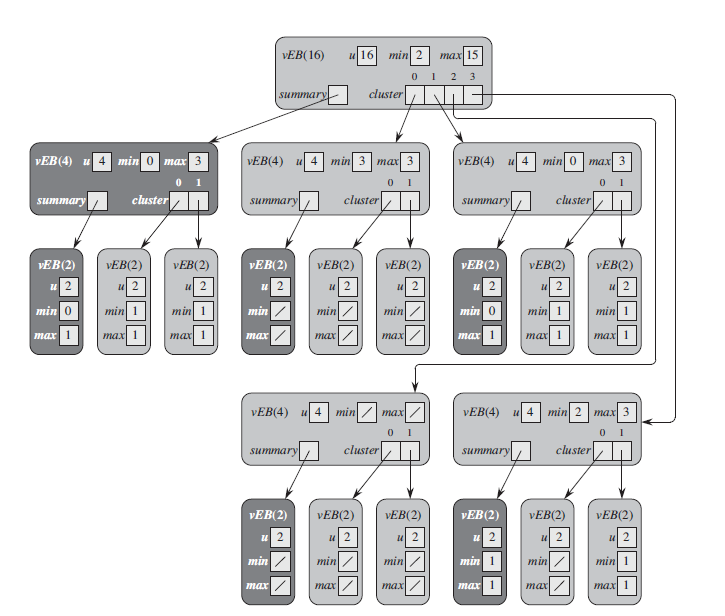Van Emde Boas Trees
Overview
A Van Emde Boas (vEB) tree is a data structure that supports operations on a dynamic set of $n$ integers from a bounded universe of size $u$. The universe size $u$ is typically expressed as $2^w$ for some integer $w$, which means $u = 2^w$.

Structure
A vEB tree for a universe of size $u$ can be thought of as a recursive structure:
-
If $u = 2$, the vEB tree is a simple base case where it can hold only two elements, and operations can be performed in constant time.
-
If $u > 2$, the vEB tree is divided into two levels: a top level and a bottom level.
- The top level, or summary, is a vEB tree of size $\sqrt{u}$.
- The bottom level consists of $\sqrt{u}$ clusters, each of size $\sqrt{u}$.
Operations
The key operations supported by a Van Emde Boas tree include the Priority Queue operations:
- Insertion
- Deletion
- Membership query (contains)
- Successor query (finding smallest element larger than a given element)
- Minimum
- Maximum
Insertion
- Determine the cluster in which $x$ belongs, i.e., $x$ is mapped to a cluster index $\lceil{x / \sqrt{u}} \rceil$ and a position within the cluster $pos = x \mod \sqrt{u}$.
- Recursively insert $pos$ into the corresponding cluster.
- If the cluster was previously empty, update the summary to reflect the presence of this cluster.
Deletion
- Determine the cluster and position within the cluster as in insertion.
- Recursively delete $pos$ from the corresponding cluster.
- If the cluster becomes empty, update the summary to reflect the absence of this cluster.
Membership query
To check if an element $x$ is present:
- Determine the cluster and position.
- Recursively check for membership in the corresponding cluster.
Successor/Predecessor
- Determine the cluster and position.
- Recursively find the successor or predecessor within the cluster or use the summary to jump to the next non-empty cluster if necessary.
Time complexity
The time complexity for each operation in a vEB tree is determined by the depth of the recursion. Each recursive step reduces the universe size from $u$ to $\sqrt{u}$. The number of recursive steps needed to reduce $u$ down to 2 is $log log u$. This is because: $log log u = log log(2^w) = log w = O(log log u)$.
Therefore, the time complexity of those operations is $O(log log u)$, where $u$ is the size of the universe.
This is significantly better than the $O(log n)$ time complexity provided by balanced binary search trees (BSTs) when $u$ is much larger than $n$.